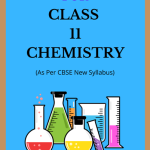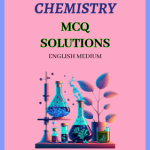NCERT Class 11 Chemistry Chapter 13 Hydrocarbons Solutions to each chapter is provided in the list so that you can easily browse through different chapters NCERT Class 11 Chemistry Chapter 13 Hydrocarbons and select need one. NCERT Class 11 Chemistry Chapter 13 Hydrocarbons Question Answers Download PDF. NCERT Chemistry Class 11 Solutions.
NCERT Class 11 Chemistry Chapter 13 Hydrocarbons
Also, you can read the NCERT book online in these sections Solutions by Expert Teachers as per Central Board of Secondary Education (CBSE) Book guidelines. NCERT Class 11 Chemistry Chapter 13 Hydrocarbons Solutions are part of All Subject Solutions. Here we have given NCERT Class 11 Chemistry Part: I, Part: II Notes. NCERT Class 11 Chemistry Chapter 13 Hydrocarbons Notes, NCERT Class 11 Chemistry Textbook Solutions for All Chapters, You can practice these here.
Hydrocarbons
Chapter: 13
| Part – II |
1. How do you account for the formation of ethane during chlorination of methane?
Ans: The formation of ethane during the chlorination of methane occurs when two methyl radicals (CH₃), generated during the chain reaction, combine. This side reaction competes with chlorination, leading to ethane (C₂H₆) as a byproduct, alongside the primary chlorinated products like chloromethane.
2. Write IUPAC names of the following compounds:
(a) CH3CH = C(CH3)2
Ans:
(b) CH2 = CH – C = C – CH3
Ans:
(c)
Ans:
(d)
Ans:
(e)
Ans:
(f)
Ans:
(g)
Ans:
3. For the following compounds, write structural formulas and IUPAC names for all possible isomers having the number of double or triple bond as indicated:
(a) C4H8 (one double bond).
Ans: The following structural isomers are possible for C₄H₈ with one double bond: Structural formulas of the isomers of C₄H₈ with one double bond are shown below.
Pent-2-ene ozonolysis produces two molecules of Pentane-2,3-dione if the reaction is performed in a reductive workup. Alternatively, if the reaction is carried out with oxidative workup, it yields two molecules of Formaldehyde and one molecule of Acetone.
(b) C5H8 (one triple bond).
Ans: The following structural isomers are possible for C5H8 with one double bond: Structural formulas of the isomers of C5H8 with one double bond are shown below.
4. Write IUPAC names of the products obtained by the ozonolysis of the following compounds:
(i) Pent-2-ene.
Ans:
Explanation: Pent-2-ene ozonolysis typically produces Pentane-2,3-dione and Formaldehyde with a reductive workup.
(ii) 3,4-Dimethylhept-3-ene.
Ans:
Explanation: 3,4-Dimethylhept-3-ene ozonolysis yields 2,3-Dimethylpentanal and 2,3-Dimethylpentan-3-one with a reductive workup.
(iii) 2-Ethylbut-1-ene.
Ans:
Explanation: 2-Ethylbut-1-ene ozonolysis results in 2-Ethylbutanal and 2-Ethylbutan-2-one.
(iv) 1-Phenylbut-1-ene.
Ans:
Explanation: Ozonolysis of 1-Phenylbut-1-ene produces Benzaldehyde and 3-Phenylpropanal.
5. An alkene ‘A’ on ozonolysis gives a mixture of ethanal and pentan-3-one. Write structure and IUPAC name of ‘A’.
Ans: The double bond is present between the carbon atoms in the two carbonyl compounds formed by ozonolysis.
6. An alkene ‘A’ contains three C – C, eight C – H σ bonds and one C – C π bond. ‘A’ on ozonolysis gives two moles of an aldehyde of molar mass 44 u. Write IUPAC name of ‘A’.
Ans: An alkene ‘A’ contains three C – C, eight C – H σ bonds and one C – C π bond. ‘A’ on ozonolysis gives two moles of an aldehyde of molar mass 44 u. Write IUPAC name of ‘A’. The formula of alkene is:
The structure of but-2-ene is
C-C bonds = Three
C-H bonds = Eight
C-C𝝅 bonds = One
7. Propanal and pentan-3-one are the ozonolysis products of an alkene? What is the structural formula of the alkene?
Ans: Following are the structural formula of the alkene:
8. Write chemical equations for combustion reaction of the following hydrocarbons:
(i) Butane.
Ans:
(ii) Pentene.
Ans:
(iii) Hexyne.
Ans:
(iv) Toluene.
Ans:
9. Draw the cis and trans structures of hex-2-ene. Which isomer will have higher b.p. and why?
Ans: The cis isomer will have a higher boiling point due to stronger dipole-dipole interactions compared to the trans isomer.
10. Why is benzene extra ordinarily stable though it contains three double bonds?
Ans: Benzene is extraordinarily stable because its π electrons are fully delocalized across six carbon atoms, leading to resonance stabilization. In the resonance hybrid, all six π electrons are spread evenly, enhancing stability.
11. What are the necessary conditions for any system to be aromatic?
Ans: The necessary conditions for a molecule to be aromatic are:
(i) It should have a single cyclic cloud of delocalized π-electrons above and below the plane of the molecule.
(ii) It should be planar. This is because complete delocalization of π-electrons is possible only if the ring is planar, allowing for cyclic overlap of p-orbitals.
(iii) It should contain Huckel number of electrons ie., (4n + 2) 𝝅-electrons where n = 0,1, 2, 3 , …….. etc.
A molecule which does not satisfy any one or more of the above conditions is said to be nom aromatic.
12. Explain why the following systems are not aromatic?
(i)
Ans: Due to the presence of one sp³-hybridised carbon, the system is not planar, preventing conjugation or resonance. As a result, the compound does not display aromatic character.
(ii)
Ans: The ring contains only four π electrons, which does not satisfy Hückel’s rule. Therefore, it is not aromatic.
(iii)
Ans: The ring has eight 𝝿 electrons and Huckel’s rule is not obeyed. It is, therefore, not aromatic.
13. How will you convert benzene into:
(i) p-nitrobromobenzene.
Ans:
(ii) m- nitrochlorobenzene
Ans:
(iii) p – nitrotoluene
Ans:
(iv) acetophenone?
Ans:
14. In the alkane H3C – CH2 – C(CH3) 2 – CH2 – CH(CH3) 2, identify 1°,2°,3° carbon atoms and give the number of H atoms bonded to each one of these.
Ans: In the alkane H₃C–CH₂–C(CH₃)₂–CH₂–CH(CH₃)₂:
In the alkane:
1° carbons (3): bonded to 3 H each
2° carbons (2): bonded to 2 H each
3° carbon (1): bonded to 1 H
Total H atoms: 14.
15. What effect does branching of an alkane chain has on its boiling point?
Ans: As branching increases in an alkane, the molecule’s surface area decreases, reducing the area of contact. This leads to weaker Van der Waals forces, which can be overcome at lower temperatures. As a result, the boiling point decreases with more branching, approaching that of a sphere with minimal surface area.
16. Addition of HBr to propene yields 2-bromopropane, while in the presence of benzoyl peroxide, the same reaction yields 1-bromopropane. Explain and give mechanism.
Ans: The addition of HBr to propane is an ionic electrophilic addition reaction where the electrophile, H⁺, first adds to form a more stable 2º carbocation. Subsequently, the carbocation is quickly attacked by the nucleophile Br⁻, resulting in the formation of 2-bromopropane.
In presence of benzoyl peroxide, the reaction is still electrophilic but the electrophile here is a Br free radical which is obtained by the action of benzoyl peroxide on HBr
In the first step, the Br radical adds to propene in a manner that generates a more stable 2º free radical. In the second step, this free radical quickly abstracts a hydrogen atom from HBr, forming 1-bromopropane.
Thus, three products are formed in total. Since none of these products can be obtained from either of the two Kekulé structures alone, this indicates that a-xylene is a resonance hybrid of the two Kekulé forms.
17. Write down the products of ozonolysis of 1,2-dimethylbenzene (o-xylene). How does the result support Kekulé structure for benzene?
Ans: Ozonolysis of 1,2-dimethylbenzene (o-xylene) produces glyoxal and two molecules of formaldehyde. This result supports the Kekulé structure by showing alternating double
Thus, in all, three products are formed. Since, all the three products cannot be obtained from any one of the two Kekule structures, this shows that a-xylene is a resonance hybrid of the two Kekule structures 1 and II)
18. Arrange benzene, n-hexane and ethyne in decreasing order of acidic behaviour. Also give reason for this behaviour.
Ans: The hybridization state of carbon in these three compounds is:
| Types of orbital: | sp2 | sp3 | sp |
| S- Character: | 33.3% | 25% | 50% |
As the s-character of the orbital in the C-H bond increases, the electrons are closer to the carbon, increasing the H-atom’s partial positive charge and acidic character. Thus, acidity decreases in the order: Ethyne > Benzene > Hexane.
19. Why does benzene undergo electrophilic substitution reactions easily and nucleophilic substitutions with difficulty?
Ans: Benzene is a planar molecule with delocalized electrons above and below the ring’s plane, making it electron-rich and highly attractive to electron-deficient species (electrophiles). Consequently, it undergoes electrophilic substitution reactions readily. Despite its delocalized electron density, electrophilic substitution is feasible. However, benzene does not undergo nucleophilic substitution because nucleophiles target areas of lower electron density.
20. How would you convert the following compounds into benzene?
(i) Ethyne.
Ans:
(ii) Ethene
Ans: Ethene is first converted into ethyne and then to benzene as shown above.
(iii) Hexane.
Ans: When hexane vapour is passed over a heated catalyst of Cr₂O₃ and MoO₃ supported on Al₂O₃ at 773 K and 10-20 atm, it cyclizes and aromatizes to form benzene.
21. Write structures of all the alkenes which on hydrogenation give 2-methylbutane.
Ans: The structures of all alkenes that yield 2-methylbutane upon hydrogenation are as follows.
22. Arrange the following set of compounds in order of their decreasing relative reactivity with an electrophile, E+.
(a) Chlorobenzene, 2,4-dinitrochlorobenzene, p-nitrochlorobenzene.
Ans: In substitution reactions, higher electron density in the benzene ring increases reactivity. Since the NO₂ group is a stronger electron-withdrawing group than Cl, more nitro groups make the compound more reactive.
Thus, the overall reactivity decreases in the order:
2,4-Dinitrochlorobenzene > p-Nitrochlorobenzene > Chlorobenzene.
(b) Toluene, p-H3C – C6H4 – NO2, p-O2N – C6H4 – NO2.
Ans: Here, the CH₃ group is electron-donating, while the NO₂ group is electron-withdrawing. Consequently, the highest electron density is in toluene, followed by p-nitrotoluene, and then p-dinitrobenzene.
Thus, the overall reactivity decreases in the order:
Toluene > p-H,C-CH-NO₂p-O₂N-CH-NO₂
23. Out of benzene, m–dinitrobenzene and toluene which will undergo nitration most easily and why?
Ans: The CH₃ group is electron-donating, while the NO₂ group is electron-withdrawing. Consequently, the electron density is highest in toluene, followed by benzene, and lowest in m-dinitrobenzene. Thus, nitration ease decreases in the order: toluene > benzene > m-dinitrobenzene. The methyl group in toluene enhances nitration, while the nitro groups in m-dinitrobenzene make it less reactive due to decreased electron density.
24. Suggest the name of a Lewis acid other than anhydrous aluminium chloride which can be used during ethylation of benzene.
Ans: Ethylation refers to the introduction of an ethyl group into the benzene ring. This is typically achieved through a Friedel-Crafts reaction involving benzene and ethyl halides (chloride or bromide), ethene, or ethanol. Catalysts used in this reaction, besides anhydrous AlCl₃, include anhydrous FeCl₃, SnCl₂, and BF₃.
25. Why is Wurtz reaction not preferred for the preparation of alkanes containing odd number of carbon atoms? Illustrate your answer by taking one example.
Ans: To prepare an alkane with an odd number of carbon atoms, two different haloalkanes are required: one with an odd number of carbon atoms and the other with an even number. For example, bromo methane and 1-bromo propane will give pentane as a result of the reaction.
However, side products can also form when the reactants couple separately. For instance, bromoethane can produce butane, and 1-bromopropane can yield hexane, complicating the reaction outcome.
Thus, a mixture of butane, pentane, and hexane will be produced. Separating these individual components from the mixture can be quite challenging.

Hi! my Name is Parimal Roy. I have completed my Bachelor’s degree in Philosophy (B.A.) from Silapathar General College. Currently, I am working as an HR Manager at Dev Library. It is a website that provides study materials for students from Class 3 to 12, including SCERT and NCERT notes. It also offers resources for BA, B.Com, B.Sc, and Computer Science, along with postgraduate notes. Besides study materials, the website has novels, eBooks, health and finance articles, biographies, quotes, and more.





